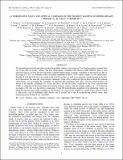A COORDINATED X-RAY AND OPTICAL CAMPAIGN OF THE NEAREST MASSIVE ECLIPSING BINARY, δ ORIONIS Aa. II. X-RAY VARIABILITY
Author(s)
Nichols, Joy S.; Corcoran, M. F.; Waldron, W.; Pollock, A. M. T.; Moffat, A. F. J.; Lauer, Jennifer L.; Shenar, T.; Russell, C. M. P.; Richardson, N. D.; Pablo, H.; Evans, N. R.; Hamaguchi, K.; Gull, T.; Hamann, W.-R.; Oskinova, Lidia M.; Ignace, R.; Hoffman, Jennifer L.; Hole, K. T.; Lomax, J. R.; Huenemoerder, David P.; Naze, Y.; ... Show more Show less
DownloadNichols-2015-A COORDINATED X-RAY.pdf (2.675Mb)
PUBLISHER_POLICY
Publisher Policy
Article is made available in accordance with the publisher's policy and may be subject to US copyright law. Please refer to the publisher's site for terms of use.
Terms of use
Metadata
Show full item recordAbstract
We present time-resolved and phase-resolved variability studies of an extensive X-ray high-resolution spectral data set of the δ Ori Aa binary system. The four observations, obtained with Chandra ACIS HETGS, have a total exposure time of ≈479 ks and provide nearly complete binary phase coverage. Variability of the total X-ray flux in the range of 5–25 Å is confirmed, with a maximum amplitude of about ±15% within a single ≈125 ks observation. Periods of 4.76 and 2.04 days are found in the total X-ray flux, as well as an apparent overall increase in the flux level throughout the nine-day observational campaign. Using 40 ks contiguous spectra derived from the original observations, we investigate the variability of emission line parameters and ratios. Several emission lines are shown to be variable, including S xv, Si xiii, and Ne ix. For the first time, variations of the X-ray emission line widths as a function of the binary phase are found in a binary system, with the smallest widths at ɸ = 0.0 when the secondary δ Ori Aa2 is at the inferior conjunction. Using 3D hydrodynamic modeling of the interacting winds, we relate the emission line width variability to the presence of a wind cavity created by a wind–wind collision, which is effectively void of embedded wind shocks and is carved out of the X-ray-producing primary wind, thus producing phase-locked X-ray variability.
Date issued
2015-08Department
MIT Kavli Institute for Astrophysics and Space ResearchJournal
The Astrophysical Journal
Publisher
IOP Publishing
Citation
Nichols, J., D. P. Huenemoerder, M. F. Corcoran, W. Waldron, Y. Naze, A. M. T. Pollock, A. F. J. Moffat, et al. “A COORDINATED X-RAY AND OPTICAL CAMPAIGN OF THE NEAREST MASSIVE ECLIPSING BINARY, δ ORIONIS Aa. II. X-RAY VARIABILITY.” The Astrophysical Journal 809, no. 2 (August 19, 2015): 133. © 2015 The American Astronomical Society
Version: Final published version
ISSN
1538-4357
0004-637X